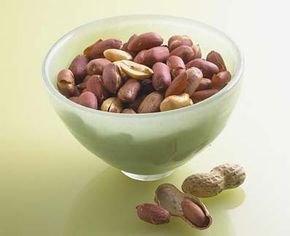There are many references to nuts in ancient times. One of the first recorded references to nuts is in the Bible. On their second journey to Egypt, Joseph's brothers brought almonds and pistachios to trade for grain. And in Numbers 17, Aaron's rod miraculously buds and bears almonds, proving he is God's chosen priest.
Almonds were a dietary mainstay of the ancient people of the Middle East; they ate sweet almonds (there are two types of almond plants, sweet and bitter; bitter almonds are used for oil and extracts) blanched, roasted, sliced, or ground. The Romans were the first to make candied almonds, and they often gave these treats as wedding presents as a symbol of fertility (a tradition still carried on today).
In the Middle Ages, almonds were ground into flour, and many recipes called for almond "milk," a drink made from ground almonds, water, and typically some sort of sweetener. Almond oil was used as medicine in many European and Middle Eastern cultures before the time of Christ. Fans of natural medicine still use it today for treating indigestion, as a laxative, and for easing coughs and laryngitis.
Pistachios also have an intriguing history. In the Bible, Jacob's sons favored pistachios, and some say they were one of the Queen of Sheba's favorite foods. According to one pistachio legend, lovers who meet under a pistachio tree on a moonlit night will find good luck if they hear the nuts crack.
Pistachios probably originated in an area that stretches from West Asia through Turkey. Romans introduced pistachios to Europe from Asia sometime around the 1st century a.d. The nuts didn't arrive in the United States until the late 19th century, and it wasn't until the 1930s that pistachios became a popular American snack food.
The history of walnuts (in this case the English walnut) is as old as the stories of almonds and pistachios. In fact, ancient inscriptions suggest walnut trees were grown in the Hanging Gardens of Babylon. Walnuts were also a valued staple in the diet of ancient Greeks and Romans.
The walnut even has a place in Greek mythology, as the god Dionysus turned his love, Carya, into a walnut tree after she died. Romans also considered walnuts food for the gods, while mere mortal citizens of Rome used walnut oil and walnut flour. Walnut oil was used extensively in the Middle Ages, and peasants ground up walnut shells to make bread. Walnuts made their way to the New World sooner than pistachios, arriving with Spanish priests in California during the 18th century.
The tough-shelled black walnut hit the world stage much later than its thin-shelled relative. This variety is also known as the American walnut and is believed to be native to North America. Historical records indicate black walnut wood was shipped to England from Virginia in about 1610.
During the mid-19th century, black walnut wood became quite fashionable, but the tree was already becoming rare. The wood experienced a revival in popularity in the 1970s, but on account of changing tastes and higher cost, the demand for black walnut wood dropped. As far as the nut itself goes, the black walnut is sweet, but not as popular as the English variety. Today the black walnut is used more widely in flavorings, such as black walnut ice cream.
Chestnuts, first mentioned by the ancient Greeks and Romans, were a major part of Middle Eastern and European diets for centuries. People also used chestnuts as medicine because they were believed to fend off rabies and dysentery. But their primary role was as a durable food source for people who lived in areas where winters were harsh and food was scarce. Chestnuts are a bit difficult to find today, except around Thanksgiving, but they are a treat for those who discover them.
Nuts enjoy an important place in modern diets. Learn about nuts in the modern age in the next section.
To learn more about nuts, see:
